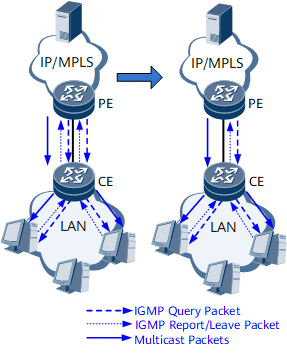IGMP Snooping Proxy
Background
Forwarding entries are generated when a Layer 3 device (PE on the network shown in Figure 1) exchanges IGMP messages with user hosts. If there are many user hosts, excessive IGMP messages will reduce the forwarding capability of the Layer 3 device.
To resolve this issue, deploy IGMP snooping proxy on a Layer 2 device (CE on the network shown in Figure 1) that connects the Layer 3 device and hosts. IGMP snooping proxy enables a Layer 2 device to behave as both a Layer 3 device and a user host, so that the Layer 2 device can terminate IGMP messages to be transmitted between the Layer 3 device and user host. IGMP snooping proxy enables a Layer 2 device to perform the following operations:
- Periodically send Query messages to hosts and receive Report and Leave messages from hosts.
- Maintain group member relationships.
- Send Report and Leave messages to a Layer 3 device.
- Forward multicast traffic only to hosts who require it.
After IGMP snooping proxy is deployed on a Layer 2 device, the Layer 2 device is not a transparent message forwarder between a Layer 3 device and user host any more. Furthermore, the Layer 3 device only recognizes the Layer 2 device and is unaware of user hosts.
Implementation
A device that runs IGMP snooping proxy establishes and maintains a multicast forwarding table and sends multicast data to users based on this table. IGMP snooping proxy implements the following functions:
IGMP snooping proxy implements the querier function for upstream devices, enabling a Layer 2 device to send Query messages on behalf of its interworking upstream device. The querier function must be enabled by deploying directly or enabling IGMP snooping proxy on a Layer 2 device if its interworking upstream device cannot send IGMP Query messages or if static multicast groups are configured on the upstream device.
IGMP snooping proxy enables a Layer 2 device to suppress Report and Leave messages if large numbers of users frequently join or leave multicast groups. This function reduces message processing workload for upstream devices.
After receiving the first Report message for a multicast group from a user host, the device checks whether an entry has been created for this group. If an entry has not been created, the device sends the Report message to its upstream device and creates an entry for this group. If an entry has been created, the device adds the host to the multicast group and does not send a Report message to its upstream device.
After receiving a Leave message for a group from a user host, the device sends a group-specific query message to check whether there are any members of this group. If there are members of this group, the device deletes only the user from the group. If there are no other members of this group, the device considers the user as the last member of the group and sends a Leave message to its upstream device.
Deployment Scenarios
IGMP snooping proxy can be used on VLANs and VPLS networks.
Benefits
IGMP snooping proxy deployed on a user-side Layer 2 router offers the following benefits:
- Reduced bandwidth consumption
- Reduced workload on Layer 3 devices directly connected to the Layer 2 router
